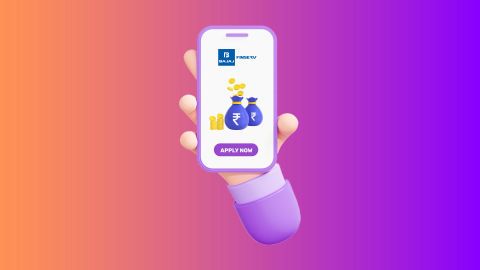Making significant expenses solely from savings may not always be feasible. Whether it's wedding costs, funding your child's higher education, or renovating your home, such large financial commitments can be challenging to manage. This is where a loan can help by providing the necessary funds while easing financial strain. In this guide, we will explore the meaning of loans, key loan information, and essential details about loans, helping you make informed financial decisions.
What is a loan?
A loan is an arrangement between a lender and a borrower in which the borrower agrees to pay back the borrowed sum in equated monthly instalments (EMIs) with an additional interest within a pre-set tenure. It is a short-term infusion of cash that must be repaid later, usually the principal and the interest payable. Know more about our personal loan
Understanding loan with an example
Let’s understand loans with a loan example. Suppose a borrower takes a personal loan of Rs. 1,00,000 at an interest rate of 11% per annum for a tenure of 3 years. The loan follows an EMI repayment structure, meaning the borrower repays the loan in fixed monthly installments over time.
Using the EMI formula, the total repayment amount comes to Rs. 1,17,859, where:
- Principal amount = Rs. 1,00,000
- Total interest paid = Rs. 17,859
- Total repayment = Rs. 1,17,859
This means the borrower pays Rs. 17,859 as the cost of borrowing Rs. 1,00,000. Understanding such loan examples helps in making informed financial decisions.
What are the uses of loan?
Personal loans are versatile financial tools. They address immediate needs like medical emergencies, home repairs, and streamlining payments. They support major life events like weddings, offering timely funds. Personal loans enable education pursuits, covering tuition and materials. Moreover, they aid in improving credit scores when repaid responsibly. However, their convenience should be balanced with personal loan interest rates and repayment terms. Wisely allocate personal loans for essential, productive, or transformative purposes that align with financial goals, avoiding unnecessary debt and ensuring a stable financial footing.
What are the factors affecting loan eligibility?
Personal loan eligibility is determined by factors like credit score, income, employment stability, and existing debt. Lenders assess the borrower's ability to repay the loan. A higher credit score enhances eligibility, showcasing responsible credit behaviour. A stable income and employment history indicate repayment capacity. Lenders might consider the debt-to-income ratio to ensure the borrower's financial stability. Age, citizenship, and location can also impact eligibility. Meeting these criteria increases the likelihood of loan approval. However, borrowers should evaluate their financial situation, borrow responsibly, and consider the loan's purpose, terms, and interest rates before applying.
How to improve your loan eligibility?
- Check credit score: Maintain a good credit score for higher eligibility.
- Clear outstanding debts: Reduce existing debts to improve your debt-to-income ratio.
- Stable employment: Lenders prefer stable employment; avoid frequent job changes.
- Income proof: Provide accurate and updated income documents.
- Lower credit utilisation: Aim for lower credit card balances compared to the credit limit.
- Timely bill payments: Ensure timely payment of bills to establish reliability.
What is the loan process?
The loan process typically involves several steps. Firstly, individuals must submit a loan application to a lender, either through a physical form or an online platform. This application includes personal and financial information, such as income, credit history, and purpose of the loan. The lender then assesses the applicant's creditworthiness, considering factors like credit score and debt-to-income ratio. Based on this evaluation, the lender approves or denies the loan.
What is a loan EMI
An EMI (Equated Monthly Instalment) is a fixed sum that a borrower pays to the lender every month as part of the loan repayment. It consists of both the principal and interest components. EMI loan means that the total loan amount, including interest, is divided into equal monthly payments, which makes repayment more manageable.
For example, if you take a loan of Rs. 1,00,000 at an 11% annual interest rate for 3 years, your monthly EMI would be calculated using a specific formula. Over the 36 months, you would repay the loan amount along with interest, resulting in fixed EMIs throughout the loan term. This structure ensures predictable payments, making it easier to budget for the future.
How is an EMI calculated?
An Equated Monthly Instalment (EMI) is a fixed amount paid each month towards repaying a loan. It includes both the principal and the interest. The EMI is calculated using this formula:
EMI = (P × r × (1 + r)^n) / ((1 + r)^n - 1)
Where:
- E = EMI (monthly payment)
- P = Loan principal
- r = Monthly interest rate
- n = Loan tenure in months
For example, if you take a loan of Rs. 1,00,000 at an 11% interest rate for 3 years, your EMI will be calculated using this formula.
To make it easier, use our interest rate calculator. It will quickly show you your EMI based on your loan amount, interest rate, and loan term.
What are the factors that influence your EMI payments?
The following are the factors that can influence your EMI:
- Principal borrowed: This is the total loan amount that the borrower has taken out.
- Loan interest rate: This is the interest rate applied to the amount borrowed.
- Tenure: The length of the loan, or the tenure, is determined by the borrower and the lender.
Things to consider before applying for a loan
Before proceeding with the application of loan, it’s important to consider a few key factors to ensure you make an informed decision:
- Understand your loan purpose
Be clear about the loan purpose. Whether it's for a home renovation, education, or personal expenses, knowing the exact reason will help you choose the right type of loan and plan your repayment accordingly. - Loan amount and eligibility
Ensure that the amount you apply for is suitable for your needs and that you meet the eligibility criteria. Lenders will assess your creditworthiness and income to determine your eligibility for the loan. - Interest rates and repayment terms
Compare interest rates and the repayment tenure across different lenders. Higher interest rates can lead to larger EMIs. Ensure the loan terms align with your financial capacity. - Online finance loan options
With the rise of digital lending, online finance loan options are more accessible and convenient. Check various platforms for the best deals. - Loan disbursement process
Be aware of the loan disbursement process. Know how quickly the loan will be credited to your account once approved and any additional documentation or verification required. - Loans information
Always read the loans information provided by the lender carefully. Look for any hidden charges or penalties to avoid surprises later.
What are the types of loans offered by Bajaj Finance?
Bajaj Finance offers a diverse range of unsecured loans including personal loan, Insta Personal Loan, gold loan, business loan, doctor loan, and more. We also have a portfolio of automotive loans such as two-wheeler finance and used car finance.
Personal loan is one of the most popular products offered by Bajaj Finance. These loans are unsecured, which means customers do not need to pledge any collateral or need a guarantor to avail of one. Additionally, our personal loans come with no restriction on end-usage. Borrowers can get Bajaj Finserv Personal Loan of up to Rs. 55 lakh with minimal paperwork and quick approval. These loans have a flexible repayment term ranging from 12 months to 96 months. Bajaj Finance offers online personal loan with 3 unique variants to its customers, including:
1. Term loan:
A term loan, is a regular personal loan, where you borrow an amount for a fixed period and repay it with fixed EMIs every month.
Know more about term loan
2. Flexi Term Loan:
With a Flexi Term Loan, you can borrow the amount from a sanctioned loan limit as many times as you need. Additionally, you pay interest only on the amount that you have utilised, and not the entire sanctioned limit.
Know more about our Flexi Term Loan
3. Flexi Hybrid Loan:
This variant of a personal loan functions just like the Flexi Term Loan. The only distinction is that your EMI will be only of the interest amount during the initial tenure.
How to calculate personal loan EMIs online?
You can use the personal loan EMI calculator to compute your EMI payments. It is an online tool that helps you figure out your monthly payments without having to do the complicated calculations manually. By using this calculator, you can plan your finances effectively in advance.
Use Bajaj Finserv Personal Loan EMI Calculator to compute your EMIs instantly without any hassle.




